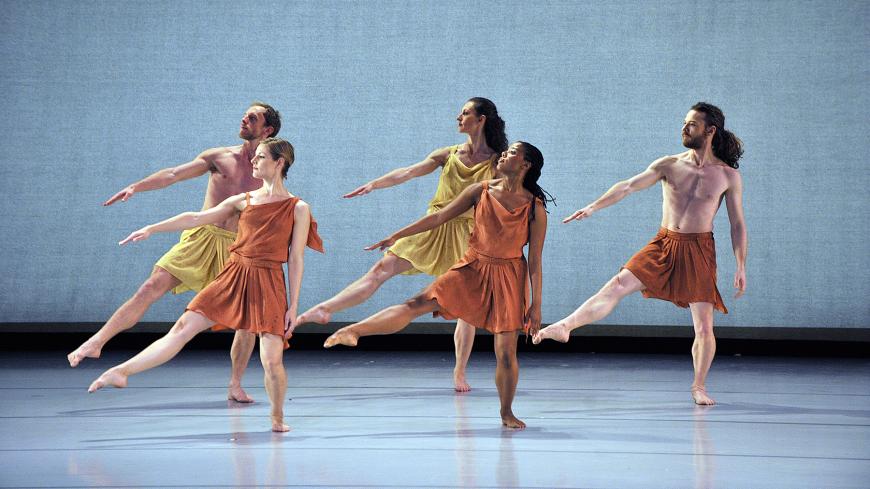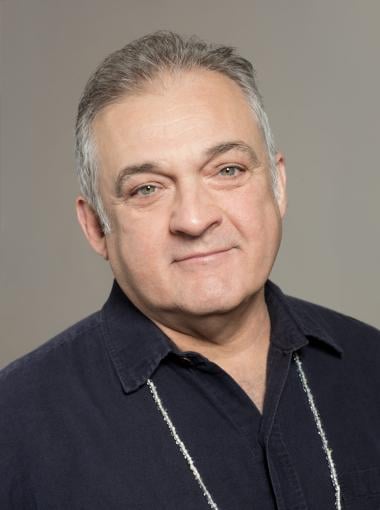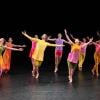
When the Mark Morris Dance Group arrives in Berkeley for its annual season at Zellerbach Hall, April 19–21, the company will be making a 180-degree turn from last season’s The Look of Love, which celebrated the music of Burt Bacharach and arrived at Cal Performances a week after the songwriter’s death. “The piece was never meant to be nostalgic or an homage,” Morris says. “But obviously, the second he died, it became a tribute. Whether we wanted it to or not, it became a monument to him, and I’m very proud of that.”

This time around, the program for Cal Performances features two very serious works — Socrates and Via Dolorosa. Morris is noted for his extremely broad knowledge of music, having worked with scores from the Baroque era through current pop music. He has staged movement for operas, paired classical chamber music with his dances, and probably could brilliantly set some choreography to a collection of ad jingles; he’s that inventive and prolific.
Socrates was shown here in 2010, so it is Via Dolorosa that is having its grand opening. Before 2020, “we were talking about doing a new piece to premiere at Cal Performances because they’ve presented my work forever and co-commissioned for decades,” explains Morris. “Obviously, we were aiming to revive a big project. We were getting it going, and we went on a casting trip to find some singers in the States and abroad. We were getting ready when, of course, we had to close it down because of the pandemic.
“I changed the ambition of this program to make it something that I could get together in a limited amount of time, with not a great deal of money, and [when] there were not huge amounts of work for everybody in this industry. Here I am at home, sulking in the plague period. I guess it was a year and a half ago when I read in The Guardian a review of a recording of this piece called The Street. It mentioned Alice [Goodman] and Nico [Muhly].” Morris had known the librettist and composer for years but had not been in touch with either for quite a while. Goodman wrote the librettos for John Adams’s operas Nixon in China (1987) and The Death of Klinghoffer (1991) while Morris set the choreography for both.
This serendipitous Guardian article would lead to the creation of Via Dolorosa. Initially it was harpist Parker Ramsay who approached Muhly to tackle a composition for solo harp based on the Stations of the Cross. Morris reveals, “I like a lot of Nico’s music but had never used any of it. I decided instantly that I wanted to choreograph The Street.”
Morris continues, “What we’re showing in our performance is the text, which is exquisitely gorgeous. It will be available as a QR code in the program, and I encourage people really to read it. I’m not going to use projections because it’s distracting and takes too long to read. The full-length version doesn’t have room for another interpretation as far as I’m concerned. [Goodman and Muhly] call it a meditation on the stations, but with the text, the music, and my dance, it’s not just the Stations of the Cross. It’s the universal, incredible point of view from Alice’s amazing theology and poetry. I listen to it all the time, and I’m sobbing.”
Socrates is paired with Erik Satie’s neoclassical score Socrate (1918). Satie’s work uses texts from Plato’s dialogues and is for solo voice accompanied by a piano or small orchestra. “This is not meant to be something loud or brash,” Morris reveals. “We’re going to show you it’s just about the quietness and the thought that goes into that whole process of dying. It’s not grim and gloomy and suicidal. It’s really very calm. I don’t prescribe my dances as medication for an ailing world.”



